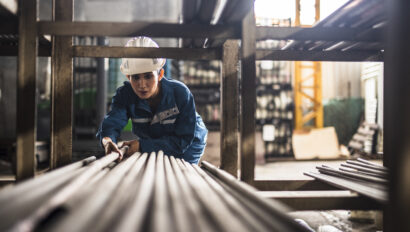As more corporations set ambitious goals to decarbonize their real estate and enhance the employee experience, sustainability continues to become more important in property management. Tenants increasingly gravitate toward smart, energy-efficient buildings that support their environmental and wellness initiatives.
Data-driven sustainability programs give property managers a leading edge by supporting environmental certifications and reducing carbon emissions — and they often pay for themselves in lower energy bills. If you want to green your building operations but aren’t sure where to start, the following are five tips for sustainable property management.
1. Engage tenants in sustainability goals
Reducing a property’s greenhouse emissions requires landlords, property managers and tenants to work together to foster a culture of sustainability. Effective, ongoing communication will help foster a collaborative relationship and ensure alignment on common goals.
As you strive to engage tenants on sustainability, you are increasingly likely to find that they share your goals. Many corporate occupiers have made ambitious – and public – commitments to net zero emissions, and reducing the carbon footprint of their real estate is a key element of reaching their targets.
Data sharing, particularly around energy performance, is critical to any engagement program. When a tenant and landlord work together to ensure data is as robust and accurate as possible, it enables them to see what’s working well, identify areas for improvement and set goals based on actual performance.
2. Drive efficiencies with smart building technologies
Today’s energy-efficient buildings rely on various smart technologies to maximize performance. Energy monitoring platforms and apps powered by machine learning can leverage data to autonomously optimize heating, ventilation and air-conditioning (HVAC), lighting and other systems in real-time. In addition to reducing energy consumption, water usage, waste and greenhouse gas emissions, these tools improve occupant comfort and health.
- Smart sensors: Internet of Things (IoT) sensors can collect data on several conditions, such as real-time occupancy, temperature, air quality, water usage and more — which can then be used to run your building more efficiently.
- Lighting systems: LED bulbs significantly reduce energy consumption compared to incandescent bulbs. Smart lighting systems can automatically adjust lighting based on occupancy, time of day and natural light levels.
- Smart windows: By automatically adjusting their light transmission based on external conditions, smart windows reduce glare and heat gain and lower the load on lighting and HVAC systems.
- HVAC optimization solutions: HVAC typically accounts for 50% of energy consumption in commercial offices, so solutions that help your HVAC system run more efficiently can make a significant sustainability impact. For example, Building Engines’ AI-powered Hank platform analyzes occupancy and external data to optimize HVAC as occupancy and weather conditions shift, cutting annual energy costs by 30% while supporting comfortable conditions. It can also save costs by scaling back energy consumption during peak pricing.
- Data management platform: With smart devices collecting a plethora of data about your building operations, you’ll need a tool to help you make sense of it all. Platforms like Hank pull together all your data into one interface so you can use it to create actionable insights.
3. Pursue sustainability certifications
Building certifications distinguish the properties that go above and beyond to reduce energy use and emissions. Some programs also recognize buildings that are making progress on issues such as circularity, health, equity, biodiversity and resilience.
While many green certification programs initially centered on building design and construction, they are evolving to reflect emissions performance throughout the whole life of the building. For example, LEED for Operations and Maintenance (O+M) and BREEAM In-use standards both focus on assessing and improving the sustainability of existing buildings. In the U.S., the ENERGY STAR rating system scores properties annually based on actual energy use, certifying buildings that meet strict energy performance standards.
There are many compelling reasons to pursue sustainability certifications. Studies have shown that they command higher rents and make your property more attractive to investors, increasing asset value.
4. Embrace preventative maintenance
Running energy-efficient buildings requires performing regular checks on building systems so your assets always operate at peak efficiency, consuming less energy. Proper upkeep of your HVAC system, lighting, generators and energy-consuming appliances supports equipment longevity, reducing waste. Regular maintenance of plumbing systems can prevent leaks, supporting water conservation efforts.
The right tools are essential to staying on top of maintenance tasks and data. Preventative maintenance software can give you visibility into equipment health and status across all properties in your portfolio.
Leading facility managers take preventative maintenance to the next level by using sophisticated technology to monitor equipment performance for irregularities such as vibration and temperature variations. When sensors detect a potential issue, facility managers receive an alert to investigate it before it becomes a larger problem. This strategy decreases waste because maintenance activities are performed only when necessary, reducing the consumption of spare parts, lubricants and other materials.
5. Embrace preventative maintenance
Smart building technologies that help reduce energy consumption create a treasure trove of data. Bringing all that data together into one central place, along with utility bills and other building health metrics, enables you to track performance and identify areas for improvement.
A robust technology platform is essential for making sense of your data. Hank, for example, analyzes HVAC data, energy usage and tenant comfort levels, learning how your building equipment operates. It integrates with your property management systems so you can view data from multiple systems and manage your portfolio through one interface.
As you evaluate tools, look for platforms with predictive dashboards to forecast future performance. You’ll want a platform that seamlessly integrates with your property management system and other tools, such as Prism. A user-friendly interface that makes sense of all your data will support your tenant engagement efforts, improve capital planning and give you the information needed to secure building certifications.
Take your sustainability efforts to the next level
Managing your building sustainably not only protects the planet but also results in happier tenants and improved asset performance. Energy-efficient buildings boast lower operating costs, helping to increase net operating income and asset value.
Investing in smart, technology-enabled solutions can help reduce your building’s carbon footprint while improving efficiency and maintaining a superior tenant experience.
Learn more about how Hank is helping building owners reduce energy consumption and operating expenses.
Related Blog Posts

Making your refit a renaissance: How technology can power efficient refits

Prism – the logical choice for owners, investors, and asset managers









